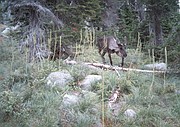Local mountain caribou herds down to seven, survey shows
The minute populations of Idaho’s mountain caribou took another blow as pregnancy test results of three cows that biologists hoped would reproduce came back negative.
That means the South Selkirk herd is down to three cows, according to biologists who conducted a three-day aerial survey in March.
Bart George with the Kalispel Tribe at Usk said the next step to ensure the continued existence of the two southernmost populations of woodland caribou — comprised now of seven animals including four across the valley in the Purcell Mountains — isn’t known.
“There’s a plan to take action, we’re just not 100 percent sure what it is,” George said.
The two populations don’t intermix, said George. The three cow population in the Selkirks spends more time on the Idaho side of the international border with Canada than the neighboring Purcell herd, which comprises three bulls and one cow.
“They are on different sides of the valley,” he said. “They don’t co-mingle.”
Biologists had planned to herd the cows into birthing pens where they could calve and raise their young for a month or more, but that plan was discarded with the negative test results.
In the past, caribou from mountain herds in British Columbia were transplanted to augment the Idaho border populations, and although some of those herds are doing equally as poorly as the Selkirk and Purcell populations, re-establishing Canadian caribou into the southern range may still be the best option.
“There are not a bunch of surplus animals that people are willing to give up,” said Norm Merz, wildlife biologist for the Kootenai Tribe.
Nonetheless, Merz said, “At this point that is part of the discussion that needs to take place.”
Last year, biologists counted 11 caribou in the local Selkirk population and 16 on the Purcell side.
Caribou are less vulnerable in winter, as they spend the cold months at high elevations away from predators. Summer and fall is the dangerous time for mountain caribou. They move from lower elevations where they calve, to higher elevations, sharing territory with deer and elk populations and the predators that follow those herds.
In addition, caribou don’t reproduce until they are 3 years old, and if successful they only have one calf per cow. There are no twins or triplets such as are common in deer, which can reproduce as yearlings.
Herds of mountain caribou in the southern range numbered around 100 to 200, a century ago, and populations fell until they teetered around 50 for many years, Wayne Wakkinen, Idaho Department of Fish and Game’s regional game manager said. The herds were augmented but they were never very populous, he said.
Lately however, due in part to the introduction of another big predator — wolves — they have seen “precipitous decline,” Wakkinen said.
“They have always kind of lived on the edge,” he said.



